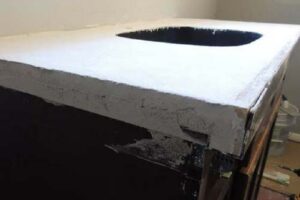The first question I’ll be answering for the series was actually asked by my best friend. She’s a red head. But that’s okay. We all have our issues. (Calm down, she knows I’m kidding…)
She’s the one that posed the question “how do I know if a house is well built?”
But this question was through text message so I had a hard time answering her without looking as though I wrote a novel. But it really is a super complicated question!
There are varying definitions of well built. Instead of well built I like to call a well built home a diamond in the rough- it has good bones but it needs a face-lift.
So how do you know if a home is a diamond in the rough? What do you look for? and where do you look for it!?!?
Since I’m currently in the process of looking for another house to flip, I thought I’d share exactly what to look for when considering a house to buy. However, there are literally ONE THOUSAND things to look at when deciding to buy a house so this post only talks about the basement… but it’s hands down, the best place to start looking in a house anyway.
How to Find Fixer Upper :: What to Look for in the Basement
 I always like to start in the basement. This is where all the good stuff is! Usually you’ll be able to see most of the mechanicals of the house down there like the plumbing, electrical and HVAC in addition to being able to see the joists and the foundation, if it’s not totally finished.
I always like to start in the basement. This is where all the good stuff is! Usually you’ll be able to see most of the mechanicals of the house down there like the plumbing, electrical and HVAC in addition to being able to see the joists and the foundation, if it’s not totally finished.
What to look for with plumbing.
Check the plumbing out for any visible splits, like the one in the picture to the right, especially if the home if vacant. This most likely means that the plumbing burst and if you find one split pipe, you’ll likely find broken pipes in multiple locations. This can also cause all the valves under every sink to split as well, so have a plumber check it all out if you suspect a pipe burst.
Also check the pipes for corrosion and leaks. If you find rusty, bluish, white or salt-looking sediments or stains around leaks you’ll know it was caused by corrosion.
Next, check out the hot water heater and expansion tank – try and look around the thing for a sticker that says when it was installed, the life expectancy of hot water heaters is only 8-10 years. But the good news is they aren’t very expensive to have replaced in the grand scheme of purchasing a home!
[foogallery id=”327″]What to look for on the joists.
Use a flashlight so you can get a good look at the beams, all the way out to where it sits in the pocket of the foundation. When examining the joists, look for any cracks in the joists and places where idiots cut away at the joists to make plumbing, electrical or other pipes fit.
 In a house we recently looked at, a plumber had cut away over half the joist under the tub to get his sewer line in and now the whole joist is split in two! Not a huge deal for us because we would just sister the joist– but be aware that sometimes sistering a joist isn’t possible because of plumbing, ductwork, or wires – which can all be moved but at a heft price.
In a house we recently looked at, a plumber had cut away over half the joist under the tub to get his sewer line in and now the whole joist is split in two! Not a huge deal for us because we would just sister the joist– but be aware that sometimes sistering a joist isn’t possible because of plumbing, ductwork, or wires – which can all be moved but at a heft price.
Also check the joists for bug damage. This could be damage from termites, boring beetles, ants and other invasive insects or animals. You can usually tell when it’s termite damage because they make these little mud tubes which are easily visible along the joists or on the walls.
Lastly, check the joists for sagging. Homes with poor structural support can experience significant sagging which can affect all the floors above causing cracks, sloping of floors and walls and detaching of outdoor concrete slabs like porches and patios.
What to look for with the electrical.
Check that the electrical panel is at least 100 amps and 100-240 volts, which is what is required in most municipalities. However, 200 amps is definitely more desirable. It will allow for expansion in the future (think down the road if you want to add a generator or power hungry workshop tools) and is a better selling point than a 100 amp. Just think of all the electronics being introduced every day… you want room to expand!
Check that there isn’t any damage or corrosion to the wiring by following the lines as far as you can around the basement. Also check the wires to see if any of the wiring is aluminum. While it’s acceptable, aluminum was substituted for copper for about a ten year period when copper prices escalated but it was discovered that aluminum was/is an inferior metal for wiring — some insurance companies won’t even ensure homes with aluminum wiring!
[foogallery id=”332″]Check out this article from angle’s list all about your electrical pitfalls.
Look for water!
Water in a basement is very common. If you see water in the basement, try and find where it originated from. For example, we recently looked at home with a flooded basement and almost put it in the “no pile” until we decided to trace where the water was actually coming from. We found that it was simply pouring in through the broken bilco door. It was literally like a waterfall coming down the stairs. Checking it from the outside, repairing the bilco door wouldn’t have caused much hassle so it was a simple fix!
However, if the water seems to be creeping in from where the wall meets the floor or just simply coming up from the ground, check for a sump pump. Sump pumps look like little open pits, usually in the corner of the basement, with a small black pump sitting in it and a pipe extended from the sump pit to the outside of the house or down the sewer drain.
If there’s water in the basement and no sump pump and no simple explanation for the water intrusion, expect to have to install a sump pump, which can run $1,000 – $2,500.
[foogallery id=”334″]
This entire basement door is moldy
Look for mold!
Water leads right into mold. A lot of bank owned homes have wet basements and even though the sump pump needs power to run, they sometimes will shut off the power to the house to save money on utilities. However, this leads to even bigger problems when the basement gets wet and there’s no running sump pump to get rid of the water. So the water sits in the basement and creates mold.
Mold is pretty easy to see but did you know that it can be black, brown, yellow, pink or green and it can even have a nasty smell and appear fuzzy or spotty? So look at the basement with a bright light so as not to miss anything!
Look for Efflorescence.
Something to look for that isn’t actually mold but looks like it is something called efflorescence. Concrete and brick will sometimes develop efflorescence which is a residue water leaves behind. It’s not harmful on it’s own, but it usually means there is excess moisture in the foundation (or wherever the efflorescence has developed) and extra attention should be paid to that area to determine if moisture remediation is needed (like grading the foundation, installing drain pipes, extended the downspouts or installing a sump pump).

THIS is Efflorescence [Source (https://www.nachi.org/efflorescence.htm)]
Lastly, check all the basement walls for cracks, settling or movement. There’s always going to be some type of settling in any house, but look for major cracks that span a good distance. Check the floor for unevenness or major settling in one area of the basement and not in another. This is a sign of a poor foundation or major problems.

There you have it! When you’re looking for a house to buy, whether it be for a flip or a fixer upper for yourself, check out the basement first… you may not even want to look at the rest of the house once you see it.
Don’t forget to subscribe for email notification when a new blog post is up!






